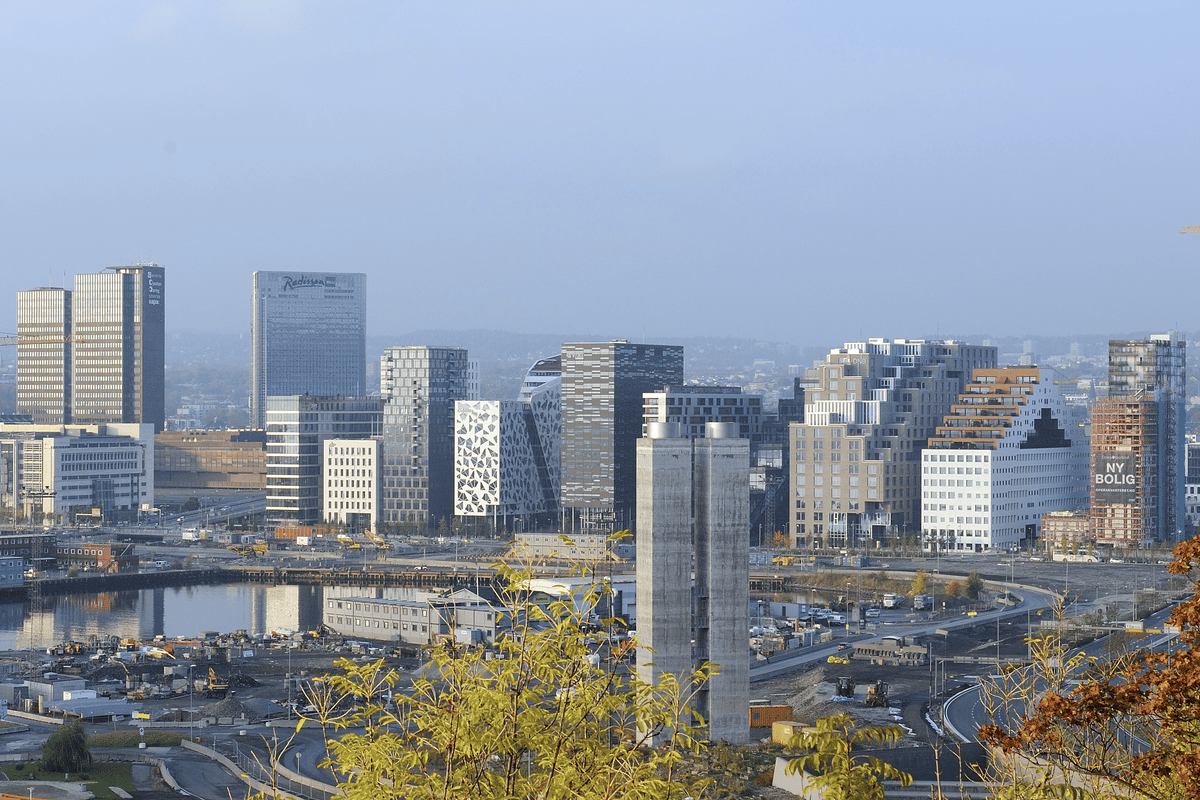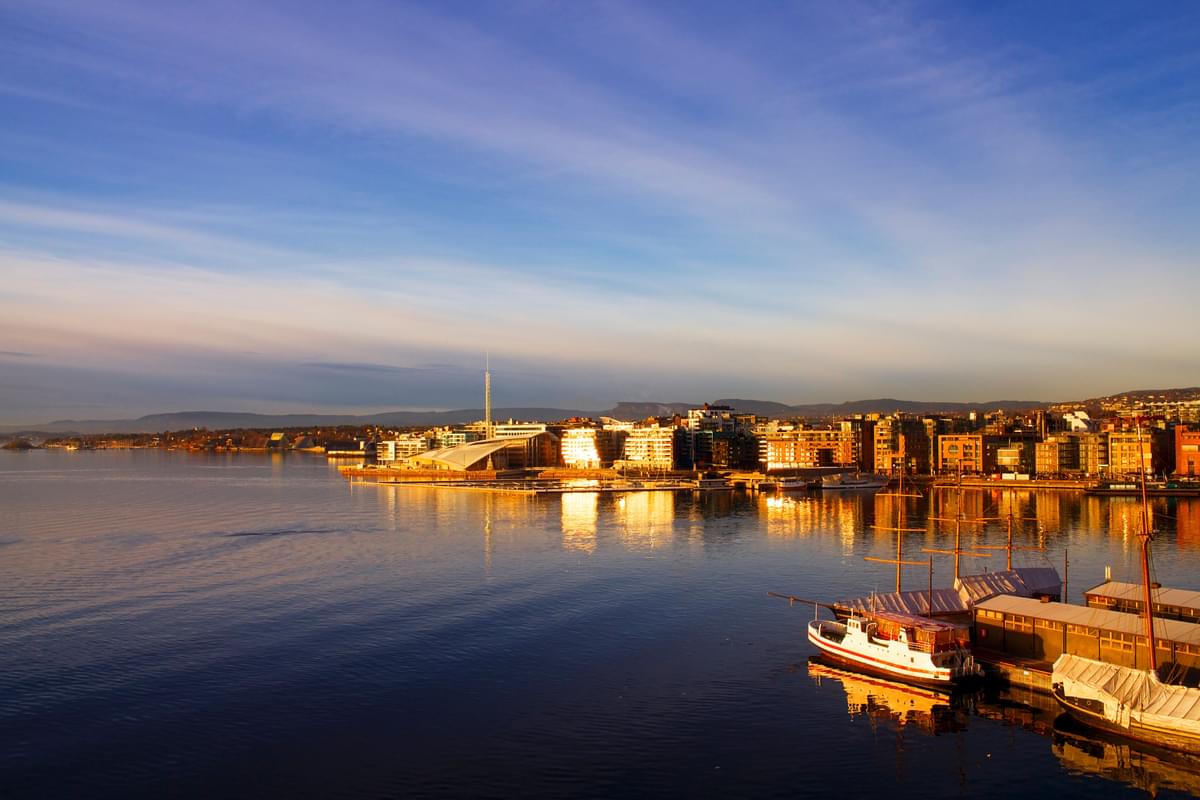
Oslo Travel Guide: Complete Tourism Tips, Top Attractions & Best Things to Do

Oslo is the capital city of Norway and one of the must-visit cities in Europe. The city is located between the Oslo Fjord and the forested hills, which present the most scenic urban experience on the continent. Oslo tourism blends modern architecture with Viking heritage, world-class museums with outdoor adventures, and cutting-edge cuisine with traditional Norwegian culture. Whether you are visiting the iconic Oslo Opera House, exploring the historic Viking Ship Museum or relaxing in a floating sauna overlooking the fjord, this Oslo travel guide covers everything you need for an unforgettable Norwegian holiday.
Key Takeaways
- Best Travel Season: Mid-May to early September offers warm weather (15°C–25°C) and up to 18 hours of daylight. December to February brings snowy landscapes perfect for winter sports, Christmas markets, and floating saunas.
- Budget Planning: Expect Rs. 10,000–18,000 per day for mid-range travel, including accommodation, meals, and attractions. Oslo is one of Europe's pricier capitals, but the Oslo Pass provides significant savings.
- Essential Planning: Allow at least 3–4 days to explore the city. Indian travellers need a Schengen visa with a 15–20 working day processing time. Apply at least 4 weeks before departure.
- Top Neighbourhoods: Stay in Sentrum for major landmarks and walkability, Aker Brygge/Tjuvholmen for waterfront dining and views, or Grünerløkka for trendy cafes and nightlife.
- Oslo's Unique Appeal: One of the few capitals where you can hike forests, ski mountains, and enjoy fjord cruises within 30 minutes of the city centre, 343 lakes lie within city limits.
Best Time to Visit Oslo: Month-by-Month Weather Guide

Oslo experiences dramatic seasonal variations throughout the year. Hence, the best time to visit Oslo depends on what you wish to experience.
Summer in Oslo (May to September)
Summer in Oslo feels like a bright, warm celebration, with temperatures ranging between 15-25°C. The season presents long daylight hours that light up the city’s fjord and parks. This sets the perfect stage for exploring the city’s scenic beaches, outdoor cafes and cultural sites. Summer is the peak tourist season, so it is recommended to book accommodations in advance.
Winter in Oslo (December to February)
Winter transforms Oslo into a fairy-tale landscape with temperatures ranging from -10°C to 2°C. The season offers a unique blend of urban charm and breathtaking natural beauty with snow cover, thereby creating the perfect conditions for skiing. The winter months from December to February are the best time to visit Oslo for snow adventurers.
Shoulder Seasons (March–April & October–November)
The shoulder season brings cooler weather with occasional rainfall, with lower accommodation and flight prices. These months provide a balance of decent weather, affordable travel and a quieter atmosphere, making it the best time to visit Oslo for a more relaxed and budget-friendly experience.
Top Attractions in Oslo You Shouldn’t Miss
Oslo offers a diverse mix of historical sites, modern landmarks, family attractions and natural scenery.
1. Oslo Opera House
The Oslo Opera House is one of the most iconic buildings in Norway. This architectural masterpiece is made of marble and glass and invites visitors to walk on the angular roof for panoramic views of the city. The building serves as a public space and is home to the Norwegian National Opera.
2. Viking Ship Museum (Vikingskipshuset)
The museum houses three beautifully preserved 9th-century Viking ships and offers an insight into Norway’s glorious past.
3. Vigeland Sculpture Park
The park is an open-air gallery that features over 200 sculptures, showcasing human forms in various life stages and emotions. The park is the largest sculpture park in the world by a single artist.
Best Things to Do in Oslo: Must-Try Experiences

Beyond museums and monuments, Oslo offers distinctive experiences that capture the city's Nordic character and natural setting.
Culinary Adventures: Norwegian Cuisine
The food scene in Oslo is a blend of seafood delicacies and traditional Norwegian dishes. The city has a range of Michelin-starred restaurants alongside authentic local eateries. Salmon and smoked fish platters, Rommegrot (sour cream porridge), Brunost (brown cheese) and Kjottkaker (Norwegian-style meatballs) are some of the must-try dishes in Norway.
Fjord Cruises & Waterfront Experiences
A fjord cruise is one of the best things to do in Oslo. The cruise offers a scenic and relaxing way to experience the city and its surrounding nature from the water.
Outdoor Activities & Nature Escapes
The surrounding Marka forests and nearby mountains in Oslo provide year-round outdoor activities. The Nordmarka Forest offers hiking trails and cross-country skiing, and the Bygdoy Peninsula features cycling routes connecting museums, beaches, and coastal walks.
How to Get Around Oslo: Transportation Guide
The Oslo Airport (OSL) is the main international gateway, with a number of connections from major Indian cities. However, there are no direct flights connecting India to Oslo, and the route requires one or more layovers.
Public Transportation System
Oslo features one of the most efficient and well-integrated public transportation systems in Europe.
- Ruter System: Ruter operates a comprehensive public transportation network in Oslo with metro (T-bane), trams, buses and ferries.
- Oslo Pass: The Oslo Pass provides free public transportation and free entry to 30+ museums and attractions.
Where to Stay in Oslo: Neighbourhood & Hotel Guide

Luxury Hotels (Rs. 25,000+ per night)
- The Thief (Tjuvholmen)
- Hotel Continental
- Amerikalinjen
- Grand Hotel Oslo
Mid-Range Hotels (Rs. 12,000–20,000 per night)
- Clarion Hotel The Hub
- Scandic Vulkan
- Radisson Blu Plaza Hotel
- Thon Hotel Opera
Budget Hotels (Rs. 6,000–12,000 per night)
- Citybox Oslo
- Anker Hostel
- Smarthotel Oslo
- K7 Hotel Oslo
Oslo Travel Cost: Complete Budget Breakdown
| Category | Budget Travel | Mid-Range Travel | Luxury Travel |
| Accommodation | Rs. 2,500–5,000 | Rs. 10,000–20,000 | Rs. 25,000–50,000 |
| Meals (3/day) | Rs. 1,500–2,500 | Rs. 3,000–5,000 | Rs. 8,000–15,000 |
| Transportation | Rs. 400–800 | Rs. 1,000–1,500 | Rs. 2,000–5,000 |
| Attractions | Rs. 1,000–2,000 | Rs. 2,500–4,000 | Rs. 5,000–10,000 |
| Daily Total | Rs. 5,400–10,300 | Rs. 16,500–30,500 | Rs. 40,000–80,000 |
Norway Visa for Indian Travellers: Complete Guide
Indian travellers must apply for a Schengen tourist visa to visit Norway. The visa grants access to Norway and all 27 Schengen member states for up to 90 days within 180 days. Applications can be submitted through VFS Global Norway Visa Application Centres, and it requires 15–20 working days.
Essential Travel Information for Oslo
| Essential | Details |
| Currency | Norwegian Krone (NOK); 1 NOK ≈ Rs. 8.5 |
| Visa | A Schengen visa is required for Indian citizens |
| Airport | Oslo Airport (OSL) |
| Transport | Buses, trams, metro, and ferries; the Oslo Pass is recommended |
| Weather | Summer (15–25°C), Winter (-10–2°C) |
| Emergency Number | 112 |
| Language | Norwegian; English are widely spoken |
Why Book Your Oslo Vacation With Us?
Oslo is a unique blend of modern Scandinavian design, tranquil fjord beauty and rich Nordic culture. From exploring world-class museums and impressive modern architecture like the Opera House to immersing yourself in the beautiful outdoor life of Vigeland Park and the Oslofjord, Oslo tourism invites you to embrace the Scandinavian way of life. Whether you wish to explore the historic Viking Ship Museum or enjoy the local cafe culture, this Oslo travel guide balances urban sophistication with natural beauty and sustainability. Plan your journey to this beautiful Scandinavian country with Pickyourtrail’s Norway Tour Package and experience a complete hassle-free travel experience.
Frequently Asked Questions About Visiting Oslo
How much does a 3-day trip to Oslo cost for Indian travellers?
A 3-day Oslo trip typically costs Rs. 30,000–50,000 per person for budget travellers, Rs. 50,000–90,000 for mid-range experiences and Rs. 1,20,000+ for luxury stays. This includes accommodation, meals, the Oslo Pass and attractions. Budget-conscious travellers can reduce costs by staying in hostels and visiting free attractions like Vigeland Sculpture Park and Ekebergparken. Flights from major Indian cities (Delhi, Mumbai, Bengaluru) to Oslo range from Rs. 40,000–70,000 round-trip, depending on season and booking timing.
Is the Oslo Pass worth buying for first-time visitors?
Yes, the Oslo Pass delivers excellent value for visitors planning to see multiple museums and use public transportation extensively. The pass works best for travellers spending 2–3 days in Oslo with plans to visit 2+ museums daily. Skip the pass if you prefer outdoor activities, plan only 1–2 museum visits, or are staying longer than 3 days and prefer flexibility.
Can you see the Northern Lights from Oslo?
No, Oslo sits too far south for reliable Northern Lights viewing. For guaranteed Northern Lights experiences, travel to Northern Norway destinations like Tromso, the Lofoten Islands or Alta. The aurora season runs from November through March, with peak viewing in January-February. Many travellers combine 3–4 days in Oslo with 3–4 days in Tromso for a complete Norwegian experience. Exploring Oslo's cultural attractions before heading north for natural phenomena.
What should I pack for Oslo in summer vs winter?
Summer packing (May–September) requires layers for variable weather. A light waterproof jacket, comfortable walking shoes, sunglasses, a sun hat and breathable clothing for warm afternoons. Evenings cool significantly, especially near the fjord, so bring a sweater or light fleece. Winter packing (December–February) demands serious cold-weather gear such as an insulated waterproof coat, thermal base layers, waterproof snow boots with good traction, insulated gloves and a scarf.
Is Oslo safe for solo female travellers?
Oslo ranks among the safest cities in Europe for solo female travellers, with extremely low crime rates, well-lit streets, reliable public transportation and a culture that respects personal space. Women commonly travel alone, dine solo and explore the city at all hours. The Ruter public transport system is safe even late at night, though standard precautions apply. Emergency services respond quickly. Dial 112 for any assistance. Solo female travellers consistently rate Oslo as one of their favourite European destinations for its combination of safety, accessibility, and welcoming atmosphere.
Update your location?



